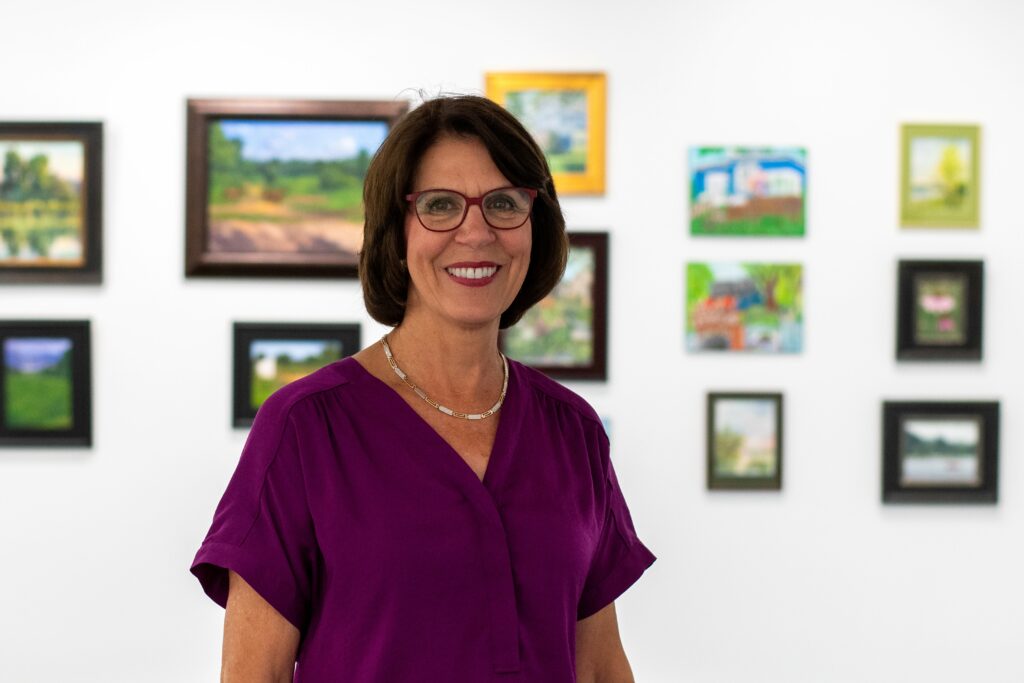Q&A with Into Nature Judge Michele Combs

When Michele Combs took her first painting class at 38 years old, she couldn’t have guessed she’d become a renowned, award-winning plein air painter. She began her painting journey in an acrylic painting class at the Minnetonka Center for the Arts, the art center where she ended up teaching. When she entered her first painting competition Primavera, the city of Plymouth’s annual springtime celebration of the arts, in 1997, it was a still life watercolor painting of a flower arrangement on a table. “It was very popular,” she said. “Three people wanted to buy it, it was exciting for me and it made me keep wanting to paint.”
Learn more about Michele and get some insight into her judging process below.
How did you get into painting?
I took my first painting class at 38 years old at the Minnetonka Center for the Arts, the place where I ended up teaching. I tell people, If you had told me that when I took my first class I would have never believed them!
I know you’re primarily an oil painter, was that first class an oil painting class?
Actually, it was acrylic. And the teacher was Kairong Liu. He’s a local artist and last I heard he had a studio in Edina.
That was 32 years ago, so when I took that first painting class and even subsequent ones, I did not know I was going to become a professional artist. I just dabbled for a while and then I found better training at the Minnesota River School of Fine Arts, which is no longer. I trained under Pat Jerde, the founder of the River School, who trained at the Atelier [Lack].
How did you move towards discovering oils?
Pretty early on. I just became interested in oils. Sometimes I would start my paintings with acrylic and then layer oils on top. I haven’t done that for years but just lately I’ve been about doing it again. When I started, I was also doing some watercolor, I would bounce between watercolor and oil because doing an oil painting seemed so exhausting, and watercolor I could get done quicker.
Oil was my favorite because it doesn’t dry so quickly and I like to work wet paint into wet paint. I like to be able to work the paint into another stroke of paint. It helps with my control of edges.
Do you remember the first time you painted en plein air?
I took an oil plein air class through the River School around 2002. I didn’t even understand all the terms they were using.
For quite a while, I just dabbled. I had a mural business for a while where I did kids’ rooms and decorative trims for kitchens and bathrooms. Then, I just kept taking more classes, and as my fine arts skills got better, I quit the mural work and just started painting on canvas.
Wow. It feels like you’ve done everything.
I’ve definitely dabbled! Before I took my first painting class, I did just about every craft imaginable. I mean, I did decorative painting, copper tooling, yarn arts, and even pottery. I did a little bit of everything but never really got accomplished at anything. When I discovered oil painting and that I could actually do something with it, I just kept going.
The reason it took me so long to take a painting class was because I didn’t think I could draw. I was not a natural drawer, I had to learn. The training at the River School really helped me because I was painting from life which I resisted for a long time because I thought it was going to be too hard. But once you start doing it, it becomes easier and makes you want to paint from life more because you develop a better understanding of the tools of painting, which are line, shape, value, color, and edge.
Why were you drawn to landscape and plein air painting?
I like being outside. After doing still life and studio work, painting outside seemed more freeing in the sense that light changes so you have to paint fast. When I took my classes, they were 12 weeks for three hours and we worked on the same still life the whole time but that sharpened my drawing skills and made me a faster painter.
Painting from life, you can see the subtle things you can’t see in a photo (which flattens an image). It’s easier to see color transitions, and how to differentiate between the light and the shade. I encourage people to paint small when they’re starting outside because you have to move fast to capture the quickly changing light patterns.
I’ve become a better studio painter by painting landscapes. Traveling to different places is stimulating.
Yes, I love the thought of a nomadic lifestyle. What’s your favorite place you’ve been to paint?
I’m inspired by new landscapes. One of my first adventures in plein air out of the country was to France and that was an absolutely awesome experience. The light and the setting over there is gorgeous. France and Italy are probably my two favorite places I’ve painted but I paint Minnesota, I’ve done plein air events all over: Red Wing, Aitkin, Grand Marais, those are beautiful places to paint in Minnesota.
How has the Minnesota landscape influenced your painting style?
Well, Minnesota teaches you how to paint greens! We have too much green here in the summer.
Minnesota has a lot of greens and blues, I’ve noticed that too!
Yes, and I love painting by the water. A lot of people like to go deep in the woods but I don’t like bugs and trees, to me, are more of a supporting structure, not the main character.
I also like that it feels like we’re painting the history of our times. Things change, landscapes, change, buildings, and bridges change and we get to capture it as it is.
Tell me about your judging process. What are you looking for in a painting?
Ultimately I’m looking for something that stands out initially and makes you want to keep coming back and looking further and someone that’s really captured the sense of place and light of day.
But more than that I’m looking for an understanding of the painting process, what Bob Upton calls the 7 C’s: A painting that’s compelling and has creativity, craftsmanship, color, etc.
Looking ahead to your Plein Air Painting class in the fall, what do you hope that students learn from the workshop?
I’m hoping they’ll come away enjoying the process of plein air, painting in general is about enjoying the process. Of course, I hope they’ll learn more technical skills, from starting a painting and learning composition but that they’ll have the enthusiasm to pursue plein air painting and discover its value.
This interview has been edited for length and clarity.
Join us for the Into Nature Community Reception on Thursday, August 15, 2024 from 6:30-8:30 PM. View all the Into Nature Plein Air Competition submissions on view in the Ford Family Gallery and hear Michele Combs choose Into Nature award winners and selected pieces to make up the Into Nature Plein Air Exhibition on display in September in the Exhibition Hall.
